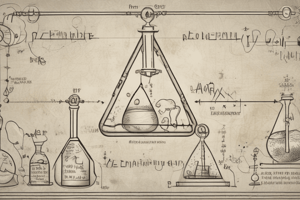Podcast
Questions and Answers
What is the advantage of using chemical formulae in chemical equations?
What is the advantage of using chemical formulae in chemical equations?
- It is not necessary to use chemical formulae
- It makes the equation more difficult to understand
- It makes the equation more concise and useful (correct)
- It makes the equation more lengthy
What is the purpose of the arrow in a word-equation?
What is the purpose of the arrow in a word-equation?
- To show the direction of the reaction (correct)
- To indicate the reactants and products are the same
- To balance the chemical equation
- To separate the reactants and products
What does a word-equation show?
What does a word-equation show?
- The chemical properties of the reactants
- The change of reactants to products (correct)
- The chemical properties of the products
- The chemical formulae of the reactants and products
What is the condition for a chemical equation to be balanced?
What is the condition for a chemical equation to be balanced?
What is the significance of the plus sign (+) in a word-equation?
What is the significance of the plus sign (+) in a word-equation?
What is the difference between a word-equation and a chemical equation?
What is the difference between a word-equation and a chemical equation?
What is the purpose of writing the notation (aq) in a chemical equation?
What is the purpose of writing the notation (aq) in a chemical equation?
Why are physical states not always included in a chemical equation?
Why are physical states not always included in a chemical equation?
What is the symbol (g) used to indicate in a chemical equation?
What is the symbol (g) used to indicate in a chemical equation?
Where are the reaction conditions, such as temperature, pressure, and catalyst, usually indicated in a chemical equation?
Where are the reaction conditions, such as temperature, pressure, and catalyst, usually indicated in a chemical equation?
What is the purpose of cleaning a magnesium ribbon before burning in air?
What is the purpose of cleaning a magnesium ribbon before burning in air?
What is the purpose of balancing a chemical equation?
What is the purpose of balancing a chemical equation?
What is the purpose of balancing a chemical equation?
What is the purpose of balancing a chemical equation?
What is the difference between a skeletal chemical equation and a balanced chemical equation?
What is the difference between a skeletal chemical equation and a balanced chemical equation?
What is the correct step to balance the chemical equation Fe + H2O → Fe3O4 + H2?
What is the correct step to balance the chemical equation Fe + H2O → Fe3O4 + H2?
What is the purpose of the arrow in a chemical equation?
What is the purpose of the arrow in a chemical equation?
What is the result of a balanced chemical equation?
What is the result of a balanced chemical equation?
What is the representation of the word-equation 'Zinc + Sulphuric acid → Zinc sulphate + Hydrogen' in a chemical equation?
What is the representation of the word-equation 'Zinc + Sulphuric acid → Zinc sulphate + Hydrogen' in a chemical equation?
Flashcards are hidden until you start studying
Study Notes
Representing Chemical Reactions
- A word-equation is a simple way to represent a chemical reaction, where reactants are written on the left-hand side (LHS) with a plus sign (+) between them, and products are written on the right-hand side (RHS) with a plus sign (+) between them.
- The arrowhead points towards the products, showing the direction of the reaction.
Chemical Equations
- A chemical equation represents a chemical reaction and can be made more concise by using chemical formulae instead of words.
- A chemical equation can be unbalanced, meaning the number of atoms of each element on the LHS and RHS of the arrow is not the same.
- A balanced chemical equation is one where the number of atoms of each element remains the same on both the LHS and RHS.
Balancing Chemical Equations
- The law of conservation of mass states that mass cannot be created or destroyed in a chemical reaction.
- To balance a chemical equation, count and compare the number of atoms of each element on the LHS and RHS of the arrow.
- Steps to balance a chemical equation: draw boxes around each formula, identify the elements, and balance the equation.
Examples of Chemical Equations
- Zn + H2SO4 → ZnSO4 + H2 is a balanced chemical equation.
- 3Fe(s) + 4H2O(g) → Fe3O4(s) + 4H2(g) is a balanced chemical equation.
Notations in Chemical Equations
- (g), (l), (aq), and (s) represent the gaseous, liquid, aqueous, and solid states of reactants and products, respectively.
- Physical states are not always included in a chemical equation, unless necessary to specify them.
- Reaction conditions, such as temperature, pressure, and catalyst, can be indicated above and/or below the arrow in the equation.
Studying That Suits You
Use AI to generate personalized quizzes and flashcards to suit your learning preferences.



